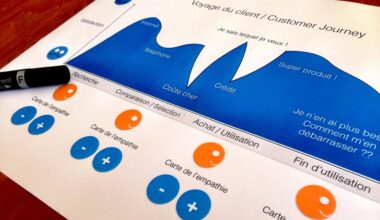Analyzing Consumer Buying Behavior to Improve Segmentation
Understanding consumer buying behavior is essential for businesses looking to enhance their marketing strategies. By segmenting customers based on their purchasing habits, companies can tailor their products and services to meet specific needs. Observing trends in buying behavior helps businesses identify various consumer categories, such as bargain hunters or premium seekers. Through survey data and analytics, organizations can create detailed consumer personas that reflect different motivations and preferences. Identifying these segments aids businesses in allocating resources effectively. Creating targeted marketing campaigns that resonate with distinct groups leads to increased engagement and loyalty. Companies can leverage behavioral data in multiple ways, such as optimizing product placement and personalizing promotional emails. Customer feedback becomes invaluable when refining these strategies. This, in turn, allows brands to adapt their offerings and messaging to suit emerging market trends. Moreover, customization boosts customer satisfaction and encourages repeat purchases, which are vital for long-term success. Ultimately, a deep understanding of buying behavior not only enhances segmentation but also fortifies the overall strategic framework of the business.
Various methodologies exist for analyzing consumer buying behavior, each yielding insights beneficial for effective segmentation. Transactional data analysis offers a window into historical consumer behavior, highlighting what products or services are most frequently purchased. Another critical approach is behavioral analytics that examines how consumers interact with digital platforms. This method unveils preferences and potential barriers impacting purchasing decisions. Utilizing web scraping techniques can also reveal competitors’ pricing strategies. Surveys, interviews, and focus groups provide qualitative data, enabling deeper emotional understanding of customers. Combining both quantitative and qualitative data creates a comprehensive picture of consumer behavior. It’s essential to apply these insights in real-time, ensuring businesses remain agile. Furthermore, advanced machine learning algorithms allow for predictive analytics, forecasting consumer buying trends before they become evident. This proactive approach prepares organizations for shifts in the market landscape. Behavioral segmentation not only enables personalized marketing, but it creates a competitive advantage. Continual testing and iteration of marketing strategies based on customer feedback keep brands at the forefront. Ultimately, businesses that excel in understanding buying behavior will thrive in increasingly competitive environments.
Importance of Customer Profiles
Create and utilize detailed customer profiles to gain actionable insights into buying behavior. Profiling helps businesses understand the unique characteristics of different consumer segments. This information includes demographic, psychographic, and behavioral aspects, which collectively inform marketing strategies. A thorough profile incorporates variables such as age, gender, income, interests, and lifestyle choices. Understanding these factors enables businesses to design products that cater to the demands of specific demographic groups. Moreover, customer profiles help identify potential upsell or cross-sell opportunities within established segments. Businesses can tailor communications based on consumer behaviors and preferences, thus personalizing advertising and marketing efforts. For instance, understanding a segment that frequently purchases eco-friendly products can guide promotional campaigns toward sustainable options. This alignment engenders trust and brand loyalty among consumers. Regularly updating customer profiles is also crucial, given that buying habits can shift over time. By leveraging insights from customer interactions and transactional data, organizations can keep up with changing consumer behaviors and preferences. The ability to adapt based on detailed profiles assures businesses remain relevant in consumers’ minds.
The implementation of segmentation strategies based on buying behavior fosters enhanced customer relationships. By understanding what drives purchases, companies can forge deeper connections with their clientele. Automation plays a key role here, with personalized content sent via email, social media, and more. Regardless of the communication channel, consumers appreciate tailored offers and recommendations. For example, a loyal customer might receive exclusive discounts or early access to new products, making them feel valued. Additionally, segmentation based on behavioral insights can orchestrate the customer journey more effectively. Touchpoints can be customized to guide consumers through their purchasing journeys, ultimately leading to higher conversion rates. Businesses can employ retargeting strategies, ensuring that potential buyers are reminded of products they viewed but did not purchase. Retargeting combined with personalization can significantly increase overall sales figures. Furthermore, integrating feedback mechanisms allows companies to assess the effectiveness of their segmentation strategies continually. Surveying customers post-purchase helps understand satisfaction levels and identifies areas for improvement. Ultimately, effective segmentation leads not only to increased sales but to long-lasting customer relationships, which remain fundamental for business sustainability.
Technological Tools for Segmentation
Adopting technological tools is crucial for precise customer segmentation based on buying behavior. Tools powered by artificial intelligence and machine learning offer invaluable capabilities in processing vast amounts of behavioral data quickly. These tools can predict consumer trends, assess changing buying behaviors, and inform marketing strategies far more efficiently than manual processes. Customer relationship management (CRM) software, when integrated with behavioral analytics, enables businesses to have a comprehensive view of interactions. These insights allow marketers to segment audiences more accurately, thus delivering personalized experiences effectively. Predictive analytics tools help forecast buyer behavior, allowing brands to adapt strategies proactively. Visual data tools can also aid in understanding consumer demographics and preferences, presenting data in easy-to-comprehend formats. Furthermore, social media analytics tools can analyze consumer sentiment and opinions, reinforcing the understanding of buying preferences. With these advanced technological resources, businesses can continually refine their strategies. Such an approach ensures that the business responds not only to current market trends but also anticipates future ones. Therefore, a strong technological foundation is essential for successful customer segmentation.
Beyond simple segmentation, embracing a comprehensive customer experience strategy that incorporates buying behavior is vital. Understanding buying behavior aids in establishing trust, ultimately leading to brand loyalty. Customers are more inclined to engage with brands that understand their needs and preferences genuinely. Implementing effective segmentation strategies allows organizations to create tailored experiences that resonate. Businesses can utilize targeted advertising to reach specific groups, increasing engagement rates. Additionally, organizations can introduce loyalty programs designed around buying patterns, enhancing retention. Positive customer experiences are likely to result in repeat purchases and referrals, creating a cycle of growth. By prioritizing customer experience linked with behavior, companies can fortify relationships with their customers. Collecting feedback is equally significant, as it provides insights into how well businesses meet consumer expectations. Utilizing technology to streamline customer interactions heightens satisfaction levels and builds loyalty over time. Each engagement provides an opportunity for brands to strengthen their relationship with consumers. As consumers expect personalized experiences, organizations that successfully cater to these needs outperform competitors. Thus, embedding consumer behavior into the customer experience strategy remains vital for success.
Future of Consumer Buying Behavior Segmentation
As consumer buying behavior evolves, so will the strategies for effective segmentation. Emerging technologies and data analytics will undoubtedly shape the future landscape of marketing. The focus will increasingly shift towards hyper-personalization, where businesses not only deliver products but also experiences tailored to individual consumer preferences. Utilizing advanced AI algorithms will enable a level of segmentation previously unattainable. Brands will be able to anticipate consumer needs, making them seem almost predictive. Behavioral segmentation will integrate seamlessly with real-time data gathered from various touchpoints. Innovations in data collection methods, such as mobile tracking and IoT devices, will also enhance understanding of consumer behavior. Marketers must embrace the dynamic nature of consumer interests and modify their approaches accordingly. Transparency and ethics in data usage will also become paramount, with consumers increasingly aware of how their data is utilized. Successful brands will prioritize building trust through genuine engagement rather than mere transactional relationships. Furthermore, driving innovation based on emerging buying trends will keep businesses relevant. Ultimately, organizations that remain adaptable to changes in consumer behavior will lead the charge in the future of segmentation.
Conclusion
Analyzing consumer buying behavior is fundamental for effective customer segmentation that enhances business success. Understanding the various dimensions that influence consumer decisions allows organizations to tailor their offerings appropriately. An effective segmentation strategy enables businesses to personalize marketing efforts, creating a lasting impact. As consumers become increasingly discerning, brands must stay agile and responsive, adjusting strategies to align with evolving needs. Utilizing technological advancements, such as data analytics and AI, supports businesses in making informed decisions. Future marketing strategies will also closely intertwine with behavioral insights, ensuring relevance. Organizations that take the time to analyze consumer buying behavior will develop more profound connections with their customer base. Moreover, fostering brand trust through effective segmentation initiates a cycle of positive reinforcement. Businesses should continuously seek feedback to refine their strategies further. The journey towards effective segmentation is ongoing and requires commitment and adaptability. Ultimately, companies that excel in this aspect will establish themselves as industry leaders, recognized for their adeptness at meeting consumers’ unique needs. As businesses embrace the intricacies of consumer behavior, a brighter future of tailored experiences lies ahead.


